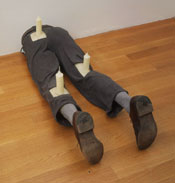6/11/2003
Mona Hatoum
MoMA QNS, Long Island City
Hatoum is the sixth artist to participate in the Artist's Choice series, for which contemporary artists are invited to organize an exhibition drawn from works in MoMA's permanent collection.

Here Is Elsewhere
Mona Hatoum (Palestinian and British, b. 1952) is the sixth artist to participate in the Artist’s Choice series, for which contemporary artists are invited to organize an exhibition drawn from works in MoMA’s permanent collection. Hatoum is a conceptual artist whose own work focuses on such issues as the instability of birthplace, shifts in gender roles, and power dynamics. For this exhibition, she has selected works by such artists as Cindy Sherman, Robert Gober, Felix Gonzalez-Torres, and Francis Alÿs.
Organized by Mona Hatoum with Fereshteh Daftari, Assistant Curator, Department of Painting and Sculpture.
BEHIND THE SCENES: An Interview with Mona Hatoum
Our upcoming exhibition Artist’s Choice: Mona Hatoum, Here Is Elsewhere is the latest installment of MoMA’s Artist’s Choice series, initiated in 1989 by the late Kirk Varnedoe, former Chief Curator of the Department of Painting and Sculpture. The guiding principle of this series is, in Varnedoe’s words, "to see the collection in a fresh new way, outside the normal patterns of chronological installation, departmental divisions, and curatorial thinking; and in parallel, to gain insight into the way contemporary artists draw inspirations from their predecessors."
Here Is Elsewhere, the sixth exhibition in this unique series, is organized by artist Mona Hatoum. How do these works reflect Hatoum’s own artistic practices? Why did this particular selection of masterpieces resonate with this contemporary artist? Excepts from our interview between exhibition co-curator Fereshteh Daftari and Mona Hatoum gives you a closer look…
Fereshteh Daftari: Unhampered by constraints regulating Museum curators and crossing MoMA's departmental boundaries, you have chosen some sixty works dating mostly from the 1990s. Can you explain how you approached this task and elaborate on any theme that emerges from your selection?
Mona Hatoum: I chose to look at work in the collection from the seventies to the present, not only because since 1975 I found myself living in London, and contemporary Western art became my context, but also because I think it was a very interesting period. Feminism has had a tremendous impact on the art world since the beginning of the seventies. I feel that examining power relationships along the gender divide also paved the way to questioning other power structures along the lines of race, class, and cultural difference.
FD: In the trajectory you have created, can you stop at (pick) specific works (or groupings), explain why they resonate with you, and elaborate on any affinity you find with your own work?
MH: I find affinities with a lot of the work in the show because of similar concerns or simply ways of working that I have employed in the past or continue to use in the present. As a student in the late seventies, I made work using my own bodily fluids and hair and nail pairings, et cetera, which makes me feel a connection with [Kiki] Smith's work with body fluids. I came across [Martha] Rosler's video when she visited the University of London, where I was in my final year as a postgraduate student. At the time, I was making installations connecting kitchen utensils together and sending 240 volts of electricity through them. So that work resonated with me.... [Francis] Alÿs's work makes me feel nostalgic for the time in the eighties when I worked mostly in performance and video and made a series of street performances and walks. The work of [Robert] Gober resonates with me because of the way he turns everyday familiar objects into uncanny or disquieting things that make you doubt the safety of the domestic environment. I also feel a lot of affinity with the ideas of [Felix] Gonzalez-Torres, especially his use of Minimalist aesthetics and formal constructs, which he "contaminates" with social meaning and subversive content.
FD: In keeping with your inclination toward ambiguity, your title, Here Is Elsewhere, allows a number of interpretations. What are the spaces that you are evoking?
MH: The title is contradictory and implies that elsewhere is right here—or the elsewhere within. It also has echoes of the famous declaration by Rimbaud: "Je est un autre" (I is another). Most of the artists in the exhibition inhabit an elsewhere or speak from a critical position outside the status quo. I suppose it is another way to make an oblique reference to the "Other" without using that very old-fashioned word. I am using this very loosely. Luce Irigaray talks about women's permanent state of exile, as they essentially exist in a culture and a language that they have not played a role in shaping. Others, because of their sexual orientation, color, or cultural background, can, if you like, be seen as literally or metaphorically in a similar state of exile.
Image:
Robert Gober. Untitled. 1991. Wax, fabric, leather, human hair, and wood, 13 1/4 x 16 1/2 x 46 1/8" (33.6 x 41.9 x 117.2 cm). Gift of Werner and Elaine Dannheisser. © 2003 Robert Gober
Artist’s Choice is made possible through The Agnes Gund Artist’s Choice Fund endowed by Iara Lee and George Gund III, Lulie and Gordon Gund, Ann and Graham Gund, and Sarah and Geoffrey Gund.
MoMA QNS
Long Island City, Queens
33 Street at Queens Blvd.
tel (212) 708-9400



